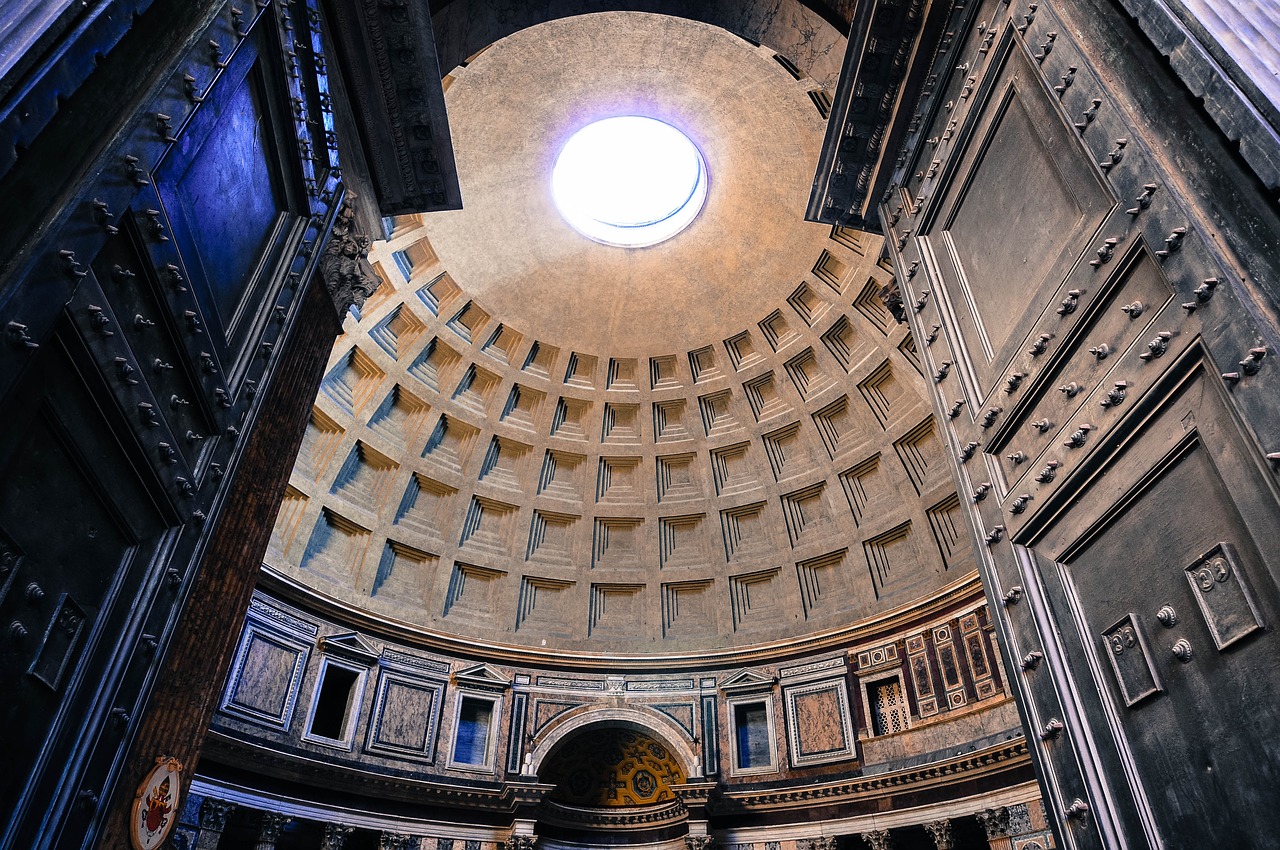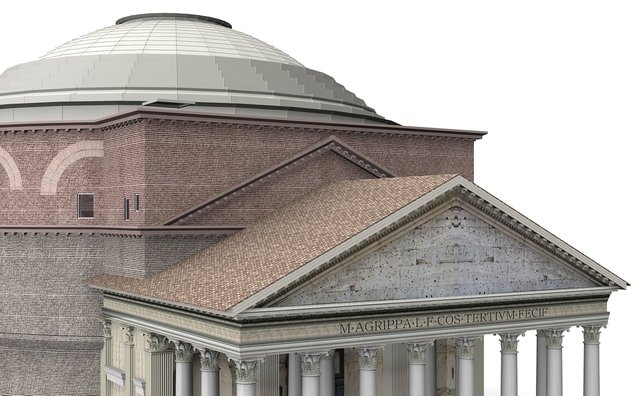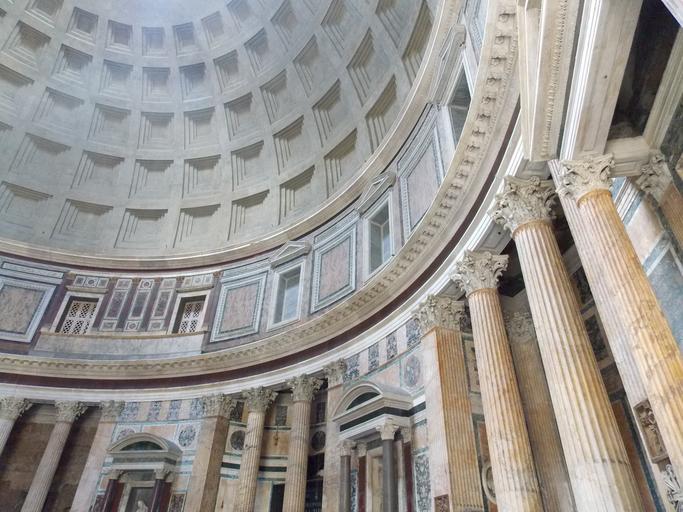How Academics Drinking in a London Pub Solved an Architectural Mystery
When I visited Rome a few years ago my knowledge of the Pantheon was as superficial as the next persons. I could recognize the building, tell you approximately how old it was (126 AD), and that’s about it. Yet like millions of pilgrims that enter its bronze doors each year, I was moved beyond words at what I encountered just beyond them. Honestly, it was an emotional experience, the magisterial beauty of the space, its symmetry, it ennobles anyone who comes into contact with it. Those of you who are following this blog and read the articles on Bramante's Tempietto and the Domes it inspired, will remember the religious significance of round, domed structures (tholos) to the Romans. Celestial is the word that best describes the feeling one has upon entering the Pantheon; celestial, pertaining to the pagan heaven, and abode of the gods.
.jpg)
My Hotel was on the Via del Corso, a few minutes walk from the Pantheon. The close proximity made it possible to stroll to the Piazza della Rotonda late at night and just hang out under the portico in the evenings, lean up against the 60 ton columns contemplating what they've witnessed on their watch. I would marvel at the trusses and columns, imagining the men who worked on them, their world being so different than my own.
Returning from Rome one would expect such interest to subside, perhaps chalking it up to Stendhal syndrome. That didn’t happen. One of the first things I did after arriving home in the States was order a book on Amazon. There are surprisingly few books that deal solely with the subject of just one building, and the Pantheon is no different. I purchased the only book I could find, a small paperback by William L. MacDonald titled, unsurprisingly, The Pantheon. Published in 1976, the book was good, informative, but it wasn’t enough. After devouring its 160 pages, my appetite for information on the edifice was left unsated, so I went back to Amazon. By chance I found a book not yet published but available for purchase. I bought it knowing it would be months before I could flip through its pages and oogle at the numerous color-plates and diagrams. I was not disappointed when it finally showed up. The 471 page tome is published by Cambridge University Press, and is titled, again, The Pantheon. I guess there's not a whole lot of options for titles there. But the book boasts in its subtitle: From Antiquity To The Present. It lives up to the boast. This scholarly volume, at times too scholarly, covers the architectural marvel from its mysterious origins to the present, and everything in between. It's no exaggeration to say that if a person reads the The Pantheon: From Antiquity to the Present, and absorbs the material, the reader will know all there is to know about this building until further scholarship reveals more in the future.

The rotunda is 142' in diameter and 142' from floor to ceiling, forming a perfect sphere.
Chapter Seven in the aforementioned book is written by an architectural historian by the name of Mark Wilson Jones. This chapter absolutely intrigued me, and if you stick around, I think you will find it fascinating also. It all began in a pub, just as the clickbait title to this post suggests. In 1987 when Mark was in his mid-twenties and hanging out in a London pub with some friends, they got to discussing some odd peculiarities about the Pantheon’s exterior that have gnawed at its critics for centuries. An insight into what academics talk about in a pub. Don’t you love it? So Mark pulled out some paper and started sketching the Pantheon from memory, and along with his fellow imbibers, tried to solve the mystery of how and why a building whose interior is symmetrical perfection, could have such asymmetrical issues on its exterior. (interior floor plan seen below)

Without going into too much boring detail, architects as illustrious as Michelangelo also formulated their own theories to explain the exteriors shortcomings (pun intended, you’ll understand later). He attributed the Pantheons peculiarities to there being three different architects involved in the design and building of the structure, leading to visible breaks in one architects work from another. Michelangelo had no evidence to base his opinion on, it was merely conjecture. But what started as alcohol fueled speculation in a London pub in 1987 has grown into a full blown theory called the "Compromise Hypothesis" which has since then been accepted in some scholarly circles, and here it is.
If you look at the computerized image below you can see the Pantheon as it was built and exists to this day. Do you notice something odd about the gabled roof of the temple portico sitting well below that decorative triangle of molding on the transitional block? Do you notice that the drum is divided into three sections by two rings of molding, neither of which lines up with the lines on the portico? These, among other things, have bothered architects for centuries.
.jpg)
This is where it gets interesting. Mark Wilson Jones proposed that the Pantheon was never intended to be built with these “errors.” If built according to the "original design," the roof of the portico would have been approximately ten feet higher than it is. Raising the whole portico ten feet would also align the molding at the bottom of the portico roof with the second line of molding on the drum. All of the peculiarities of the Pantheon’s exterior would be solved, Mr. Jones reasoned, by using 50’ columns rather than the 40’ columns that were used. His thesis? The building was designed for 50’ columns. Some unknown calamity during construction necessitated switching from the 50’ columns called for in the original plans, to the 40’ columns we see on the building today. There are other tell-tale signs under the portico that point to an on-site adaption having been made to the shorter columns.


The two computerized images above, created by John Burge, make it very easy to digest all the architectural mumbo-jumbo. On the left is the Pantheon as it exists with the 40' columns. On the right is how the Pantheon would appear with 50'columns; the Pantheon as originally intended, according to Mark Wilson Jones' thesis. It looks pretty damn convincing to me. No more triangular molding on the transitional block. The roof of the portico is raised, diminishing the size of the block behind it. The center molding on the rotunda drum lines up perfectly with the molding at the bottom of the portico roof-line. It is a much more symmetrical elevation, and pleasing to the eye. Now you can understand the pun about the exteriors shortcomings. The columns are too short.
Though the evidence is convincing, Mr. Jones' theory has yet to be proven. It is doubtful if it ever can be proven. But assuming he is correct, what happened to the original 50' columns intended for the Roman Pantheon? That too will remain a mystery. But we do know that some of the columns on the Pantheon were quarried at Mons Claudianus, in the eastern deserts of Egypt. Now stop for a second and think about that. Each 40' column -there are sixteen in the Portico- weighs 60 tons, or 120,000 pounds. Architects estimate the taller, wider, 50' columns would weigh nearly twice that, or well over 100 tons per column.
Before hydraulics, engines, steam power, cables, using only block and tackle, levers, beasts of burden and man-power, the monoliths were transported from quarries in Egypt, across the Mediterranean Sea on Roman cargo ships to the Port of Ostia, from where they were floated up the Tiber river on barges to Rome. Were the 50' columns lost at sea? Any number of logistical problems could have necessitated switching to the smaller, lighter, columns. It is even postulated that they were re-directed to another, more pressing building project. All of these questions will remain unanswered. Scholars will debate the subject ad infinitum. And the Pantheon will remain silent, in all of its grandeur and splendor.
Here is an interesting article on the Pantheon's columns for further reading.
Pantheon floor plan image credit
.jpg)
Wow, this is more than I have ever known and my son is amazed. Now Im in trouble because he wants to see this......>LOL
Absolutely fascinating! I so enjoyed your brilliantly written article as much as the topic. The language is impeccable and the whole post flows so effortlessly that I couldn't stop reading. Wow! As to the scholarly theory, a puzzle for the aeons I'm sure, which could be the purpose of the deliberate oops, or perhaps attributed to the influence of Dionysus, they were after all only human then...
Thank you emerald. It’s always a challenge condensing long winded academic jargon to digestable Steemit fare.Glad you liked it. Have you been to Rome and the Pantheon?
Mi? I've never left South Africa. But I'm fortunate to have seen some of the most exquisitely beautiful places in the universe, right here. Interestingly, I'll be going to the UK this year, Oxford based, and a veritable whirlwind tour of a variety of touristy attractions which I'm eagerly looking forward to, despite the long flight.
PS My husband is of the opinion that no mistakes were made in the building of the Pantheon and the design was intentional to allow for rainwater dispersion :)
That’s the thing with theories, they’re fun to knock around, but in the end it’s just an educated guess. Academics have to do something to justify their existence, so they propagate theories. But I do like Jones’ “new and improved” version.
I think I missed my calling! I should have been an academic, although I'm probably basing my opinion on a limited understanding, but I love the idea of postulating, hypothesising and theorising based on research and logical deduction!
My father in law has a keen interest in architecture and history, amongst a plethora of other disciplines, I'm going to relate this story to him. I'm sure he'll enjoy it and I'll be interested to hear his take on Jones' theory. Yes it's a great theory and makes me realise that great thinkers still abound! Thanks for the chat.
Your father in law sounds like a cool guy. Like a jerk I somehow neglected to include the name of Jones’ theory. It’s called the “compromise hypothesis” in case he wished to look it up.
As for your calling, you’re already doing it, just not professionally. You’re a layman, or layperson in today’s environment of nit pickers. A curious and open mind can’t be minted in a university. There are many dullards with degrees, and many closeted “academics” who never had the opportunity to get the piece of paper. See ya.
It's an intriguing explanation. It's not like the Mediterranean Sea is devoid of shipwrecks. Quite the opposite. It's been too long since I last listened to Mike Duncan's History of Rome podcast, so I can't recall the particulars of what else was happening when the Pantheon was built. It could also have been as simple as a budget shortfall, although it is unwise to scrimp when it comes to deities if you're a believer in the Roman pantheon, so that's unlikely.
Jones’ hypothesis explores a number of possibilities, one of which was repurposing the 50’ columns for another project in Rome or elsewhere. As beautiful as the Pantheon is, it was built while Rome was at a peak in wealth and power. Another project deemed more important may have commandeered them. It’s possible too that Jones is wrong and it was built as intended, except I cant get past the superior elevation drawings with the taller columns.